-
Origin: Granny Smith apples were first discovered in Australia in the 1860s by Maria Ann Smith, hence the name "Granny Smith."
-
Appearance: These apples have a bright green skin that can sometimes have a slight blush of red. The skin is often firm and smooth.
-
Flavor: Granny Smith apples are known for their tart and tangy flavor. They have a crisp and juicy texture, making them refreshing to bite into.
-
Culinary Uses: Due to their tartness, Granny Smith apples are excellent for baking. They hold their shape well and add a tangy flavor to pies, tarts, and crisps. They are also great for making applesauce, apple butter, and apple cider
|
Type: |
|
|
Origins: |
Central Asia and Afghanistan |
|
Height: |
12' - 15' |
|
Spread: |
12’ - 15' |
|
Spacing: |
12' |
|
USDA Hardiness Zone: |
6 - 9 |
|
Culture: |
|
|
Bloom Color: |
White |
|
Season of Interest: |
MAINTENANCE NEEDS: High Maintenance. Water Regularly. Potential issues include apple scab, cedar apple rust, fire blight, leaf spot and and powdery mildew. Possible pests are aphids, maggots, boreres, and spider mites. Most commercially available Apples are grafted onto their rootstock, resulting in dwarf (8-10ft), Semi-dwarf (12-15ft) or standard tree heights all with full sized fruits. Ask the provider the rootstock classification for estimated size. Dwarf stock is easier to maintain and produces fruit at an earlier age.
LANDSCAPE USES: Accents or Group Plantings, Borders, Wildlife Gardens, Shade Tree, Edible Garden, and Container.
COMPANION PLANTS: Apple, Shasta Daisy, Bugleweed
Image: Kolforn (Wikimedia)}, 2018-07-30 Granny smith (Malus pumila) cooking apples, Trimingham, CC BY-SA 4.0
*As plants have ranges in appearance they may not appear as the images shown.



















































